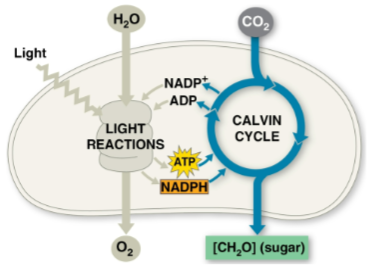Concept 10.4: The Calvin cycle uses the chemical energy of ATP and NADPH to reduce carbon dioxide to sugar
1/5
Name | Mastery | Learn | Test | Matching | Spaced |
|---|
No study sessions yet.
6 Terms

Calvin cycle
An anabolic process within the stroma of the chloroplast that builds sugar from smaller molecules using ATP with the reducing power of electrons carried by NADPH
Has the three phrases of carbon fixation, reduction, and regeneration of the CO2 acceptor (RuBP)
Consumes 9 ATP and 6 NADPH overall to make 1 G3P molecule for other molecular synthesis processes, which are regenerated with light reactions
Glyceraldehyde 3-phosphate (G3P)
The sugar that is produced from carbon that enters as CO2
One of these requires three complete cycles to fix three CO2 molecules
Carbon fixation
The binding of CO2 to a five-carbon sugar named ribulose biphosphate, catalyzed by RuBP carboxylase-oxygenase (rubisco)
This is then split into two molecules of 3-phosphoglycerate for each CO2 fixed
Rubisco
Enzyme that catalyzes the binding of CO2 to ribulose biphosphate in carbon fixation
Reduction
The phosphorylation of each molecule of 3-phosphoglycerate by six ATP and six NADPH to produce a G3P sugar
Results in a 3:6 CO2 input to G3P output ratio
Only one G3P molecule can be counted as a net gain of carbohydrate as it is passed on, the rest remain to regenerate the CO2 acceptor RuBP
Regeneration of RuBP
The rearrangement of the five molecules of G3P in a complex series of reactions to yield three molecules of RuBP
This uses three additional ATP molecules